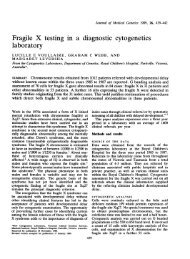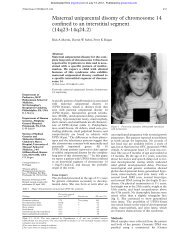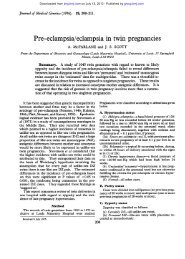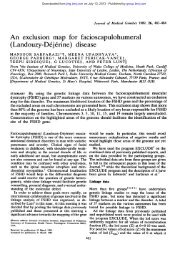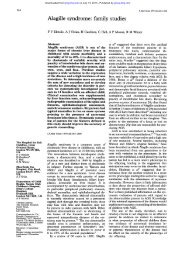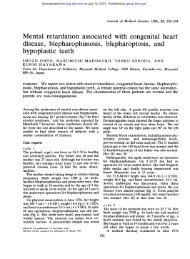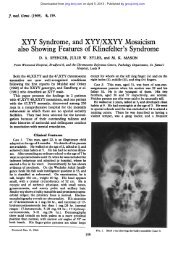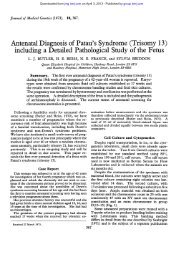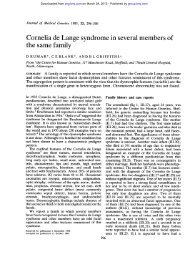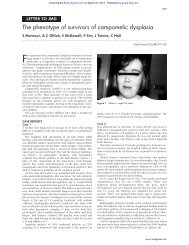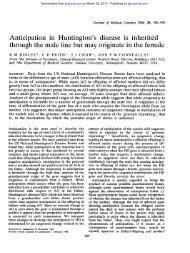Uveal Coloboma and True Klinefelter Syndrome - Journal of Medical ...
Uveal Coloboma and True Klinefelter Syndrome - Journal of Medical ...
Uveal Coloboma and True Klinefelter Syndrome - Journal of Medical ...
Create successful ePaper yourself
Turn your PDF publications into a flip-book with our unique Google optimized e-Paper software.
Downloaded from<br />
jmg.bmj.com on April 5, 2013 - Published by group.bmj.com<br />
<strong>Uveal</strong> <strong>Coloboma</strong> <strong>and</strong> <strong>True</strong> <strong>Klinefelter</strong> <strong>Syndrome</strong><br />
,,,., %....A<br />
second time in 160o (orcein stain), the third time in 10%<br />
(Shorr stain). These results indicated the presence <strong>of</strong><br />
two X chromosomes.<br />
The drumstick evaluation revealed 0-4% polymorphs<br />
with a drumstick appendage. The lobulation <strong>of</strong> the<br />
polymorphs was extremely low.<br />
Cytogenetic evaluation was also performed in the<br />
patient's parents. The karyotype <strong>of</strong> the mother was<br />
normal (46,XX), both numerically <strong>and</strong> structurally.<br />
The karyotype <strong>of</strong> the father was numerically normal<br />
(46,XY). Structurally, most karyotypes showed a long<br />
Y chromosome, the relative length <strong>of</strong> which was generally<br />
even longer than in the prob<strong>and</strong> (Fig. 6). The mean<br />
Y/F index was 1-13.<br />
Dermatoglyphic examination (Table I). This<br />
was carried out on the prob<strong>and</strong> <strong>and</strong> his parents.<br />
Total finger ridge count. Prob<strong>and</strong>, not determined;<br />
ulnar loops on all fingers, except on right thumb on<br />
which a whorl was present. Father, 68; mother, 146.<br />
Axial triradius <strong>and</strong> atd angle. Prob<strong>and</strong>, distal displacement<br />
to position t", more pronounced on the left<br />
FIG. 6. G group chromosomes in karyotypes <strong>of</strong> the patient <strong>and</strong> his<br />
father.<br />
FIG. 5. Karyotype with 2n=46,XX (propositus).<br />
h<strong>and</strong>; atd right, 570; atd left, 68°. Father, triradius in<br />
position t; atd right, 430; atd left, 40°. Mother, distal<br />
displacement <strong>of</strong> axial triradius to position t'; atd right,<br />
48°; atd left, 540.<br />
Digital triradii. Prob<strong>and</strong>, left h<strong>and</strong>; triradius c absent.<br />
Father, all present; mother, all present.<br />
a-b ridge count. Prob<strong>and</strong>, right 32, left 40, summed<br />
72. Father, right, not counted because <strong>of</strong> burn scars;<br />
left 40. Mother, right 37, left 37, summed 74.<br />
.............<br />
TABLE I<br />
FORMULAE OF DERMATOGLYPHS<br />
Main Line Index<br />
Prob<strong>and</strong> r fRight Left 11.9.0.5'.13.t'.0.0.0.0.0 11.9.7.5'.13.tr.O.O.O.L.0 16<br />
Father fRight Not RLeft 11.7.7.3.13.t.O.O.O.O.L determined<br />
14<br />
Mother fRight 9.9.57.5'.13t'°.O.O.O.L.D 14<br />
Left 11.9.7.5.'.13.t'.O.O.O.L.0 16<br />
215<br />
Discussion<br />
A: Sex Chromosomal Anomalies<br />
The sex chromatin values suggested the presence <strong>of</strong><br />
two X chromosomes. The extremely low nuclear<br />
lobulation <strong>of</strong> the polymorphonuclear leucocytes,<br />
observed in our prob<strong>and</strong>, has been reported as<br />
typical for <strong>Klinefelter</strong> syndrome (Mittwoch, 1964;<br />
Fr0l<strong>and</strong>, 1969).<br />
The blood cultures revealed the presence <strong>of</strong> two<br />
main cell lines <strong>of</strong> about equal importance: 46,XX/<br />
47,XXY. The XX/XXY type <strong>of</strong> mosaicism has<br />
been reported a few times in the <strong>Klinefelter</strong><br />
syndrome (Ford et al., 1959; Hayward, 1960;<br />
Rohde, 1963; Court Brown et al., 1964).





